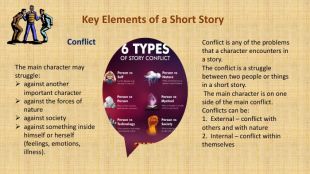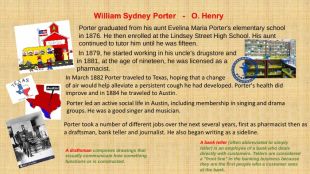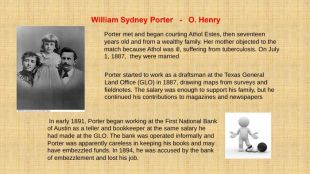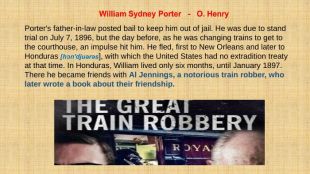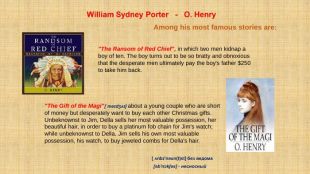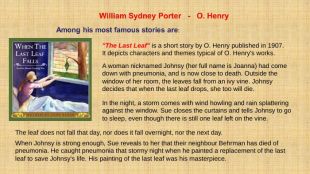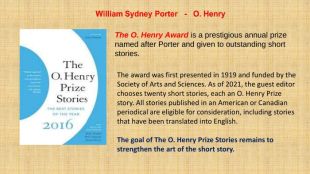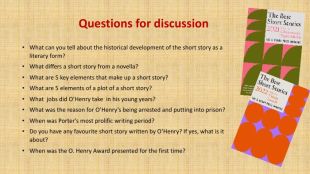Оповідання як жанр літератури. О’Генрі (презентація)















![While he was in Houston, federal auditors audited the First National Bank of Austin and found the embezzlement shortages that led to his firing. A federal indictment followed and he was arrested on charges of embezzlement. In April 1895 his writing and drawings had caught the attention of the editor at the Houston Post. Porter and his family moved to Houston in 1895, where he started writing for the Post. His salary was only $25 a month, but it rose steadily as his popularity increased. [ɪn'daɪtmənt] - официальное обвинение While he was in Houston, federal auditors audited the First National Bank of Austin and found the embezzlement shortages that led to his firing. A federal indictment followed and he was arrested on charges of embezzlement. In April 1895 his writing and drawings had caught the attention of the editor at the Houston Post. Porter and his family moved to Houston in 1895, where he started writing for the Post. His salary was only $25 a month, but it rose steadily as his popularity increased. [ɪn'daɪtmənt] - официальное обвинение](/uploads/files/2059233/324353/354056_images/16.jpg)
![Porter's father-in-law posted bail to keep him out of jail. He was due to stand trial on July 7, 1896, but the day before, as he was changing trains to get to the courthouse, an impulse hit him. He fled, first to New Orleans and later to Honduras [hɔn'djuərəs], with which the United States had no extradition treaty at that time. In Honduras, William lived only six months, until January 1897. There he became friends with Al Jennings, a notorious train robber, who later wrote a book about their friendship. Porter's father-in-law posted bail to keep him out of jail. He was due to stand trial on July 7, 1896, but the day before, as he was changing trains to get to the courthouse, an impulse hit him. He fled, first to New Orleans and later to Honduras [hɔn'djuərəs], with which the United States had no extradition treaty at that time. In Honduras, William lived only six months, until January 1897. There he became friends with Al Jennings, a notorious train robber, who later wrote a book about their friendship.](/uploads/files/2059233/324353/354056_images/17.jpg)







Analyse the elements of the short story, using excerpts and summaries from works by Washington Irving, Edgar Allan Poe, and Katherine Mansfield that show character development, setting, mood, plot, conflict, theme, point of view, and the author's writing style. The Short Story as a Literary Form. Explore the historical development of the short story, beginning with the literary traditions of the ancient cultures of Egypt, Greece, Rome, and China, and continuing with the storytelling traditions of medieval Europeans and the Eskimos. Survey the tradition of oral storytelling and examine the short story as a literary form. Explain the cultural significance of fables, ballads, romances, myths, legends, folktales, and epic poems, and discuss their role as precursors to the short story.
https://www.youtube.com/watch?v=a. Cc. Rr40 Nu. Ks&ab_channel=Zane. Education. Oral Storytelling: An Ancient Tradition (Short Story Writing Part 1)https://www.youtube.com/watch?v=o. Hl. Nmst2v4o&ab_channel=Zane. Education. The Short Story as a Literary Form (Short Story Writing Part 2)The Short Story as a Literary Form
The story is very close to the novella. A short story differs from a novella by a more expressive composition, the presence of descriptions, reflections, and digressions. The conflict in the story, if there is one, is not as acute as in the novel. The narration in the story is often conducted from the person of the narrator. A story is a small prose work, the plot of which is based on a specific (rarely several) episode from the life of one (sometimes several) character. The small size of the story requires an unbranched, as a rule, one-line, clear plot structure. The characters are shown mostly in a formed form. There are few descriptions, they are concise and laconic. An important role is played by an artistic detail (a detail of everyday life, a psychological detail, etc.).
Key Elements of a Short Story. Character. A character is a person, or sometimes an animal, who takes part in the action of a short story or other literary work. Characters and how we get to know them: Through the author’s physical description of them. Through their actions. Through their words (dialogue)Through their inner thoughts. Through what other characters say and think about them
Key Elements of a Short Story. Theme. Theme is the meaning behind events and characters’ actions in a story. The theme is the central idea, message, or purpose in a short story. A theme can be expressed as a general statement about people or life. It is NOT plot summary. It can be either directly or indirectly stated by the author. Most likely indirectly. Popular Story Themes
Key Elements of a Short Story. Conflict. Conflict is any of the problems that a character encounters in a story. The conflict is a struggle between two people or things in a short story. The main character is on one side of the main conflict. Conflicts can be:1. External – conflict with others and with nature2. Internal – conflict within themselves. The main character may struggle:against another important characteragainst the forces of natureagainst societyagainst something inside himself or herself (feelings, emotions, illness).
Key Elements of a Short Story. Exposition. The start or introduction of the story. The background information that the reader must have in order to understand the story. This is where characters and setting are introduced. Rising Action. All of the events that take place leading up to the climax. This is where the reader is introduced to the conflict. Climax. The most exciting part of the story. The turning point in the story. Here the story is turned in a different direction, toward the conclusion. Falling Action. The immediate reaction to the climax. All the actions that occur after the climax and before the conclusion of the story. Resolution. The conclusion of the plot. Loose ends are tied up. There might not be a clear resolution. (This is called a cliffhanger ending.)
https://www.youtube.com/watch?v=p. YXP875sg0g&t=892s&ab_channel=Audiopedia. William Sydney Porter - O. Henry(September 11, 1862 – June 5, 1910)William Sydney Porter , known by his pen name O. Henry, was an American short story writer. His stories are known for their surprise endings. William Sidney Porter was born in Greensboro, North Carolina. He changed the spelling of his middle name to Sydney in 1898. His father was a physician. When William was three, his mother died from tuberculosis. As a child, Porter was always reading, everything from classics to dime novels.
In 1879, he started working in his uncle's drugstore and in 1881, at the age of nineteen, he was licensed as a pharmacist. Porter graduated from his aunt Evelina Maria Porter's elementary school in 1876. He then enrolled at the Lindsey Street High School. His aunt continued to tutor him until he was fifteen. In March 1882 Porter traveled to Texas, hoping that a change of air would help alleviate a persistent cough he had developed. Porter's health did improve and in 1884 he traveled to Austin. Porter led an active social life in Austin, including membership in singing and drama groups. He was a good singer and musician. Porter took a number of different jobs over the next several years, first as pharmacist then as a draftsman, bank teller and journalist. He also began writing as a sideline. A draftsman composes drawings that visually communicate how something functions or is constructed. A bank teller (often abbreviated to simply teller) is an employee of a bank who deals directly with customers. Tellers are considered a "front line" in the banking business because they are the first people who a customer sees at the bank.
Porter met and began courting Athol Estes, then seventeen years old and from a wealthy family. Her mother objected to the match because Athol was ill, suffering from tuberculosis. On July 1, 1887, they were married Porter started to work as a draftsman at the Texas General Land Office (GLO) in 1887, drawing maps from surveys and fieldnotes. The salary was enough to support his family, but he continued his contributions to magazines and newspapers In early 1891, Porter began working at the First National Bank of Austin as a teller and bookkeeper at the same salary he had made at the GLO. The bank was operated informally and Porter was apparently careless in keeping his books and may have embezzled funds. In 1894, he was accused by the bank of embezzlement and lost his job.
While he was in Houston, federal auditors audited the First National Bank of Austin and found the embezzlement shortages that led to his firing. A federal indictment followed and he was arrested on charges of embezzlement. In April 1895 his writing and drawings had caught the attention of the editor at the Houston Post. Porter and his family moved to Houston in 1895, where he started writing for the Post. His salary was only $25 a month, but it rose steadily as his popularity increased. [ɪn'daɪtmənt] - официальное обвинение
Porter's father-in-law posted bail to keep him out of jail. He was due to stand trial on July 7, 1896, but the day before, as he was changing trains to get to the courthouse, an impulse hit him. He fled, first to New Orleans and later to Honduras [hɔn'djuərəs], with which the United States had no extradition treaty at that time. In Honduras, William lived only six months, until January 1897. There he became friends with Al Jennings, a notorious train robber, who later wrote a book about their friendship.
Athol Estes Porter died from tuberculosis on July 25, 1897. Porter had little to say in his own defense, and was found guilty of embezzlement in February 1898, sentenced to five years in prison. Porter was released on July 24, 1901 for good behavior after serving three years. Unfortunately, Athol became too ill to meet Porter in Honduras as he had planned. When he learned that his wife was dying, Porter returned to Austin in February 1897 and surrendered to the court.
Porter's most prolific writing period started in 1902, when he moved to New York City to be near his publishers. Most of O. Henry's stories are set in his own time, the early 20th century. Many take place in New York City and deal for the most part with ordinary people: policemen, waitresses, etc. While there, he wrote 381 short stories. O. Henry's stories frequently have surprise endings.
Among his most famous stories are:"The Ransom of Red Chief", in which two men kidnap a boy of ten. The boy turns out to be so bratty and obnoxious that the desperate men ultimately pay the boy's father $250 to take him back.[əb'nɔkʃəs] - несносный"The Gift of the Magi"[ˈmeɪdʒʌɪ] about a young couple who are short of money but desperately want to buy each other Christmas gifts. Unbeknownst to Jim, Della sells her most valuable possession, her beautiful hair, in order to buy a platinum fob chain for Jim's watch; while unbeknownst to Della, Jim sells his own most valuable possession, his watch, to buy jeweled combs for Della's hair. [ˌʌnbɪ'nəun(t)st] без ведома
"The Cop and the Anthem“ is about a New York City hobo named Soapy, who sets out to get arrested so that he can be a guest of the city jail instead of sleeping out in the cold winter. Despite efforts at petty theft, vandalism, disorderly conduct, and "mashing" with a young prostitute, Soapy fails to draw the attention of the police. Disconsolate, he pauses in front of a church, where an organ anthem inspires him to clean up his life—and is ironically charged for loitering (байдикування) and sentenced to three months in prison.
A woman nicknamed Johnsy (her full name is Joanna) had come down with pneumonia, and is now close to death. Outside the window of her room, the leaves fall from an ivy vine. Johnsy decides that when the last leaf drops, she too will die. In the night, a storm comes with wind howling and rain splattering against the window. Sue closes the curtains and tells Johnsy to go to sleep, even though there is still one leaf left on the vine. The leaf does not fall that day, nor does it fall overnight, nor the next day. When Johnsy is strong enough, Sue reveals to her that their neighbour Behrman has died of pneumonia. He caught pneumonia that stormy night when he painted a replacement of the last leaf to save Johnsy's life. His painting of the last leaf was his masterpiece."The Last Leaf" is a short story by O. Henry published in 1907. It depicts characters and themes typical of O. Henry's works.
The O. Henry Award is a prestigious annual prize named after Porter and given to outstanding short stories. The award was first presented in 1919 and funded by the Society of Arts and Sciences. As of 2021, the guest editor chooses twenty short stories, each an O. Henry Prize story. All stories published in an American or Canadian periodical are eligible for consideration, including stories that have been translated into English. The goal of The O. Henry Prize Stories remains to strengthen the art of the short story.
Questions for discussion. What can you tell about the historical development of the short story as a literary form?What differs a short story from a novella?What are 5 key elements that make up a short story?What are 5 elements of a plot of a short story?What jobs did O’Henry take in his young years?What was the reason for O’Henry’s being arrested and putting into prison?When was Porter's most prolific writing period?Do you have any favourite short story written by O’Henry? If yes, what is it about?When was the O. Henry Award presented for the first time?


про публікацію авторської розробки
Додати розробку









